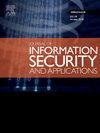A novel approach for real-time DDoS detection in SDN using dimensionality reduction and ensemble learning
IF 3.7
2区 计算机科学
Q2 COMPUTER SCIENCE, INFORMATION SYSTEMS
Journal of Information Security and Applications
Pub Date : 2025-09-01
DOI:10.1016/j.jisa.2025.104195
引用次数: 0
Abstract
This paper presents an innovative approach to detecting Distributed Denial of Service (DDoS) attacks in Software-Defined Networking (SDN) environments by integrating dimensionality reduction, feature engineering, and ensemble learning techniques. The proposed method leverages a two-stage dimensionality reduction process utilizing Principal Component Analysis (PCA) and t-Distributed Stochastic Neighbor Embedding (t-SNE), which effectively captures both linear and non-linear patterns in network traffic. Feature augmentation is further achieved through K-Means clustering, which enhances the feature set by providing valuable cluster-based insights, thereby improving model performance. Evaluated on a comprehensive SDN dataset, the approach achieves a highest observed detection accuracy of 99.93% using an ensemble model, highlighting its effectiveness in distinguishing between malicious and benign traffic. Notably, machine learning models such as Random Forest and XGBoost demonstrate exceptional performance, with XGBoost providing outstanding computational efficiency by processing predictions in just 0.187 s. This highlights its suitability for real-time DDoS detection and significantly outpaces traditional methods in both detection accuracy and processing speed. The ensemble learning technique applied further improves classification robustness, making the method highly reliable in dynamic SDN environments. These findings underscore the efficacy of combining dimensionality reduction, feature engineering, and advanced machine learning methods to address critical security challenges in SDN environments, providing a scalable and efficient solution for mitigating DDoS attacks.
基于降维和集成学习的SDN实时DDoS检测新方法
本文通过集成降维、特征工程和集成学习技术,提出了一种在软件定义网络(SDN)环境中检测分布式拒绝服务(DDoS)攻击的创新方法。该方法利用主成分分析(PCA)和t分布随机邻居嵌入(t-SNE)的两阶段降维过程,有效捕获网络流量中的线性和非线性模式。通过K-Means聚类进一步实现特征增强,该聚类通过提供有价值的基于聚类的洞察力来增强特征集,从而提高模型性能。在综合SDN数据集上进行评估,该方法使用集成模型实现了99.93%的最高观察检测准确率,突出了其区分恶意和良性流量的有效性。值得注意的是,像Random Forest和XGBoost这样的机器学习模型展示了出色的性能,XGBoost通过在0.187秒内处理预测提供了出色的计算效率。这突出了它适合实时DDoS检测,并且在检测精度和处理速度上都大大超过了传统方法。集成学习技术的应用进一步提高了分类鲁棒性,使该方法在动态SDN环境下具有较高的可靠性。这些发现强调了将降维、特征工程和先进的机器学习方法结合起来解决SDN环境中的关键安全挑战的有效性,为减轻DDoS攻击提供了可扩展且高效的解决方案。
本文章由计算机程序翻译,如有差异,请以英文原文为准。
求助全文
约1分钟内获得全文
求助全文
来源期刊

Journal of Information Security and Applications
Computer Science-Computer Networks and Communications
CiteScore
10.90
自引率
5.40%
发文量
206
审稿时长
56 days
期刊介绍:
Journal of Information Security and Applications (JISA) focuses on the original research and practice-driven applications with relevance to information security and applications. JISA provides a common linkage between a vibrant scientific and research community and industry professionals by offering a clear view on modern problems and challenges in information security, as well as identifying promising scientific and "best-practice" solutions. JISA issues offer a balance between original research work and innovative industrial approaches by internationally renowned information security experts and researchers.
 求助内容:
求助内容: 应助结果提醒方式:
应助结果提醒方式:


